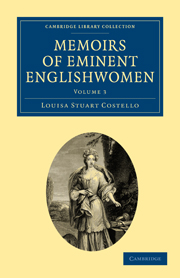Book contents
- Frontmatter
- Contents
- ANASTASIA VENETIA STANLEY, LADY DIGBY
- THE COUNTESS OF DESMOND
- ELIZABETH CROMWELL AND HER DAUGHTERS
- MRS. LUCY HUTCHINSON
- FRANCES STUART, DUCHESS OF RICHMOND
- DOROTHY SIDNEY, COUNTESS OF SUNDERLAND
- ELIZABETH PERCY, DUCHESS OF SOMERSET
- LADY RACHEL RUSSELL
- MARGARET, DUCHESS OF NEWCASTLE.
- ANNE, COUNTESS OF WINCHELSEA
- MRS. KATHERINE PHILIPS
- JANE LANE
- ANNE KILLIGREW
- FRANCES JENNINGS, DUCHESS OF TYRCONNEL
- MARY BEALE
- ANNE CLARGES, DUCHESS OF ALBEMARLE
- LADY MARY TUDOR
- ANNE HYDE, DUCHESS OF YORK
- ANNE SCOTT, DUCHESS OF MONMOUTH
- STELLA AND VANESSA
- SUSANNAH CENTLIVRE
- Plate section
THE COUNTESS OF DESMOND
Published online by Cambridge University Press: 05 March 2012
- Frontmatter
- Contents
- ANASTASIA VENETIA STANLEY, LADY DIGBY
- THE COUNTESS OF DESMOND
- ELIZABETH CROMWELL AND HER DAUGHTERS
- MRS. LUCY HUTCHINSON
- FRANCES STUART, DUCHESS OF RICHMOND
- DOROTHY SIDNEY, COUNTESS OF SUNDERLAND
- ELIZABETH PERCY, DUCHESS OF SOMERSET
- LADY RACHEL RUSSELL
- MARGARET, DUCHESS OF NEWCASTLE.
- ANNE, COUNTESS OF WINCHELSEA
- MRS. KATHERINE PHILIPS
- JANE LANE
- ANNE KILLIGREW
- FRANCES JENNINGS, DUCHESS OF TYRCONNEL
- MARY BEALE
- ANNE CLARGES, DUCHESS OF ALBEMARLE
- LADY MARY TUDOR
- ANNE HYDE, DUCHESS OF YORK
- ANNE SCOTT, DUCHESS OF MONMOUTH
- STELLA AND VANESSA
- SUSANNAH CENTLIVRE
- Plate section
Summary
The chief interest attached to this singular lady, is her repute for extreme old age, in which she divides the palm with that “old, old, very old man,” the famous Thomas Parr, who was her contemporary.
Antiquaries have been at a loss at what exact epoch to fix her birth, which must have been about the middle of the fifteenth century. Sir Walter Raleigh, in his “History of the World,” says that he was acquainted with “the old Countess of Desmond of Inchiquin, who was married in Edward the Fourth's time, and held her jointure from all the Earls of Desmond since then; and that this is true, all the noblemen and gentlemen of Munster can witness.”
Lord Orford has a curious paper of inquiry, which comes under the head of his “Historic Doubts,” relative to this lady. His conviction was, that Richard III. was not the monster, either of cruelty or deformity, which the Lancastrian historians represent him; and he was anxious to establish the fact of the period of the Countess of Desmond's birth, in order to prove, from her authority, that Richard was as handsome as his brother Edward.
It seems that the old Lady Dacre had seen and conversed with Lady Desmond; and to her she related passages of her early life, when, a young beauty, she appeared at the gay and brilliant court of Edward, and at a ball was the partner in a galliard, or coranto, of Richard, Duke of York, with whose gallantry and grace she seemed to be delighted, affirming that he was a remarkably wellmade man.
- Type
- Chapter
- Information
- Memoirs of Eminent Englishwomen , pp. 24 - 33Publisher: Cambridge University PressPrint publication year: 2010First published in: 1844



